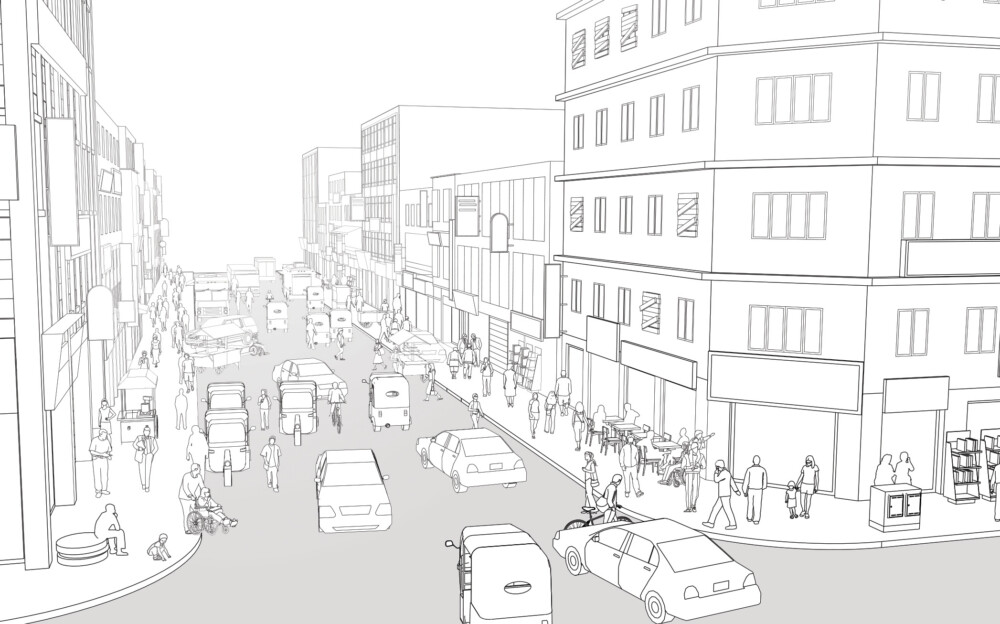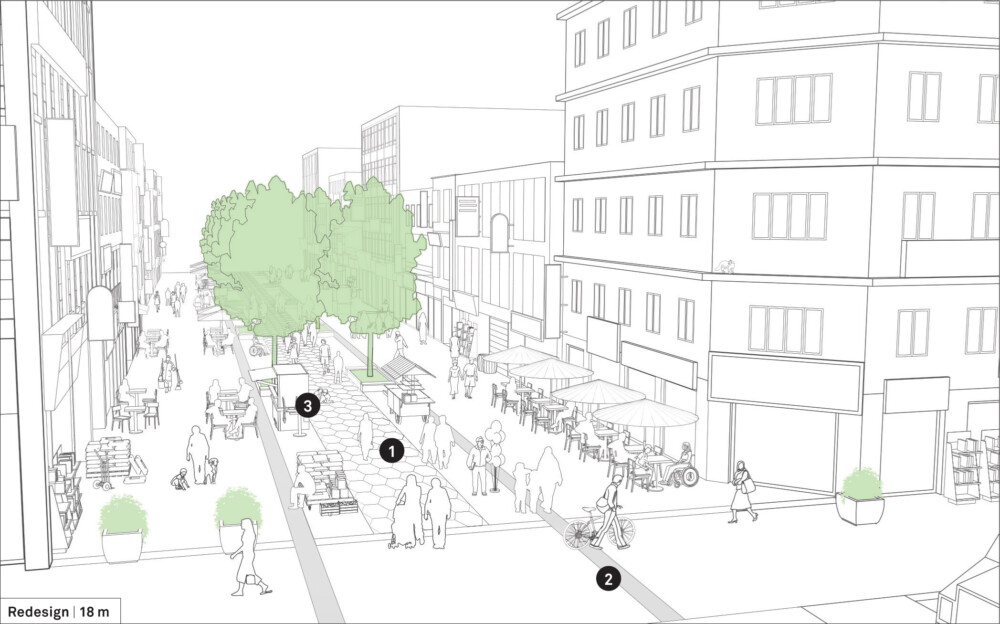-
About Streets
- Introduction
- Defining Streets
-
Shaping Streets
- The Process of Shaping Streets
- Aligning with City and Regional Agendas
- Involving the Right Stakeholders
- Setting a Project Vision
- Communication and Engagement
- Costs and Budgets
- Phasing and Interim Strategies
- Coordination and Project Management
- Implementation and Materials
- Management
- Maintenance
- Institutionalizing Change
- Measuring and Evaluating Streets
-
Street Design Guidance
- Designing Streets for Great Cities
- Designing Streets for Place
-
Designing Streets for People
- Utilities and Infrastructure
- Operational and Management Strategies
- Design Controls
-
Street Transformations
- Streets
-
Intersections
- Intersection Design Strategies
- Intersection Analysis
- Intersection Redesign
- Mini Roundabout
- Small Raised Intersection
- Neighborhood Gateway Intersection
- Intersection of Two-Way and One-Way Streets
- Major Intersection: Reclaiming the Corners
- Major Intersection: Squaring the Circle
- Major Intersection: Cycle Protection
- Complex Intersection: Adding Public Plazas
- Complex Intersection: Improving Traffic Circles
- Complex Intersection: Increasing Permeability
- Resources
Global Street Design Guide
-
About Streets
- Introduction
- Defining Streets
-
Shaping Streets
Back Shaping Streets
- The Process of Shaping Streets
- Aligning with City and Regional Agendas
- Involving the Right Stakeholders
- Setting a Project Vision
- Communication and Engagement
- Costs and Budgets
- Phasing and Interim Strategies
- Coordination and Project Management
- Implementation and Materials
- Management
- Maintenance
- Institutionalizing Change
-
Measuring and Evaluating Streets
Back Measuring and Evaluating Streets
-
Street Design Guidance
-
Designing Streets for Great Cities
Back Designing Streets for Great Cities
-
Designing Streets for Place
Back Designing Streets for Place
-
Designing Streets for People
Back Designing Streets for People
- Comparing Street Users
- A Variety of Street Users
-
Designing for Pedestrians
Back Designing for Pedestrians
- Designing for Cyclists
-
Designing for Transit Riders
Back Designing for Transit Riders
- Overview
- Transit Networks
- Transit Toolbox
-
Transit Facilities
Back Transit Facilities
-
Transit Stops
Back Transit Stops
-
Additional Guidance
Back Additional Guidance
-
Designing for Motorists
Back Designing for Motorists
-
Designing for Freight and Service Operators
Back Designing for Freight and Service Operators
-
Designing for People Doing Business
Back Designing for People Doing Business
-
Utilities and Infrastructure
Back Utilities and Infrastructure
- Utilities
-
Green Infrastructure and Stormwater Management
Back Green Infrastructure and Stormwater Management
-
Lighting and Technology
Back Lighting and Technology
-
Operational and Management Strategies
Back Operational and Management Strategies
- Design Controls
-
Street Transformations
-
Streets
Back Streets
- Street Design Strategies
- Street Typologies
-
Pedestrian-Priority Spaces
Back Pedestrian-Priority Spaces
-
Pedestrian-Only Streets
Back Pedestrian-Only Streets
-
Laneways and Alleys
Back Laneways and Alleys
- Parklets
-
Pedestrian Plazas
Back Pedestrian Plazas
-
Pedestrian-Only Streets
-
Shared Streets
Back Shared Streets
-
Commercial Shared Streets
Back Commercial Shared Streets
-
Residential Shared Streets
Back Residential Shared Streets
-
Commercial Shared Streets
-
Neighborhood Streets
Back Neighborhood Streets
-
Residential Streets
Back Residential Streets
-
Neighborhood Main Streets
Back Neighborhood Main Streets
-
Residential Streets
-
Avenues and Boulevards
Back Avenues and Boulevards
-
Central One-Way Streets
Back Central One-Way Streets
-
Central Two-Way Streets
Back Central Two-Way Streets
- Transit Streets
-
Large Streets with Transit
Back Large Streets with Transit
- Grand Streets
-
Central One-Way Streets
-
Special Conditions
Back Special Conditions
-
Elevated Structure Improvement
Back Elevated Structure Improvement
-
Elevated Structure Removal
Back Elevated Structure Removal
-
Streets to Streams
Back Streets to Streams
-
Temporary Street Closures
Back Temporary Street Closures
-
Post-Industrial Revitalization
Back Post-Industrial Revitalization
-
Waterfront and Parkside Streets
Back Waterfront and Parkside Streets
-
Historic Streets
Back Historic Streets
-
Elevated Structure Improvement
-
Streets in Informal Areas
Back Streets in Informal Areas
-
Intersections
Back Intersections
- Intersection Design Strategies
- Intersection Analysis
- Intersection Redesign
- Mini Roundabout
- Small Raised Intersection
- Neighborhood Gateway Intersection
- Intersection of Two-Way and One-Way Streets
- Major Intersection: Reclaiming the Corners
- Major Intersection: Squaring the Circle
- Major Intersection: Cycle Protection
- Complex Intersection: Adding Public Plazas
- Complex Intersection: Improving Traffic Circles
- Complex Intersection: Increasing Permeability
- Resources
- Guides & Publications
- Global Street Design Guide
- Streets
- Pedestrian-Priority Spaces
- Pedestrian-Only Streets
- Example 1: 18 m
Example 1: 18 m


Existing Conditions
Traffic congestion and commercial activities might block the sidewalks and overtake the pedestrian environment.
Destinations on both sides of the street result in frequent mid-block crossing and multiple desire lines.
Pedestrian-only streets might function as a shopping street, with dense commercial and mixed-use activity, serving high pedestrians volumes.
Design Guidance
Explore pedestrianization when pedestrians overflow onto the roadbed on a regular basis.
Carefully select streets to be pedestrianized based on immediate context. Lack of pedestrians can render these streets unsafe and uninviting. Pedestrian-only streets should be situated in high-density, mixed-use office or commercial areas where pedestrian numbers are high.
Pedestrian-only streets must be well connected to collective transit, cycle routes, and walking paths. Access from side streets or through streets should offer multiple options to move in and out of the corridor, keeping the space permeable. See: Pedestrian Networks.
Provide drop-off and pick-up points for vehicles carrying passengers with ambulatory difficulties.
![]() Minimum clear paths should be maintained to allow emergency vehicle access. Prohibit parking and vehicular traffic to ensure that clear paths remain unobstructed.
Minimum clear paths should be maintained to allow emergency vehicle access. Prohibit parking and vehicular traffic to ensure that clear paths remain unobstructed.
Provide a smooth and level surface to optimize walking accessibility. While clear paths are not required to be straight and direct, they must be continuous and navigable.
![]() Use durable and slip-resistant materials. Provide accessibility ramps and tactile paving to assist the visually impaired.
Use durable and slip-resistant materials. Provide accessibility ramps and tactile paving to assist the visually impaired.
![]() Add street furniture, artwork, seating, tables, benches, trees, landscaping, cycle racks, and water fountains to add character and support a range of activities.
Add street furniture, artwork, seating, tables, benches, trees, landscaping, cycle racks, and water fountains to add character and support a range of activities.
Restrict loading access to certain times of day, preferably off-peak hours, for local businesses and residences.
Lighting must support a safe environment. Facade lighting, pedestrian-scale light poles, and shorter light fixtures can be used to evenly light the space. See: Lighting Design Guidance.
Schedule regular maintenance to keep the space clean. Waste receptacles should be provided, and their number based on pedestrian volumes.
Program activities and events, particularly if the corridor is long. Create frontage zones and vendor spaces to organize on-street activity. Ensure breaks are provided between vendor areas to maintain visibility and permeability.
Adapted by Global Street Design Guide published by Island Press.
Next Section —